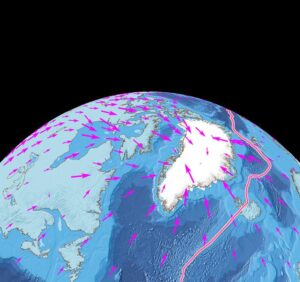World Thaw 10,000 Years In the past Could Have Fueled Volcanoes and Sped Up Continental Drift


Melting glaciers in North America 10,000 years in the past might have given continental drift a little bit of a push. Comparable exercise in Greenland now might ultimately set off volcanic eruptions in Iceland.
Geoscientists modeled a series of occasions that exhibit how sea degree rise impacts plate tectonics, they report within the journal Nature.
“As ice quantity was vastly lowered, it triggered an enormous movement in Earth’s crust,” Tao Yuan, a graduate scholar at Colorado College, Boulder, and an writer of the paper, stated in a press launch. “Scientists knew that the ice melting triggered the plates to uplift. However we present that in addition they moved loads horizontally because of the ice melting.”
Ice Melting and Plate Tectonics
The geoscientists primarily based their simulation’s begin at 26,000 years in the past, when the Laurentide Ice Sheet, which coated a lot of North America, began receding. Melting ice raised sea ranges just below half an inch a yr, they calculated.
This world thaw might have sped up the tectonic plate on which a lot of North America sits by as much as 25 % between 12,000 years and 6,000 years in the past. The soften might have additionally elevated the speed at which the North American and Eurasian plates unfold aside by as a lot as 40 %.
Learn Extra: 5 of the Most Explosive Volcanic Eruptions
Rethinking Continental Drift’s Velocity
The research might trigger us to rethink the pace at which plate tectonics happens. The method has lengthy been thought of a gradual, leisurely (dare we are saying glacial?) one. Shorter bursts of exercise — a minimum of on a geological timescale — can also have vital impacts on how the planet reshapes itself sooner or later.
“That story that we’ve been telling for an extended, very long time — that processes like seafloor spreading and continental drift function at timescales of tens of millions of years pushed by Earth’s inner engine, thermal convection,” Shijie Zhong, a CU, Boulder physics and co-author of the paper, stated in a press launch. “That’s nonetheless true, however we present that glacial forcing also can trigger important movement on comparatively brief timescales of 10,000 years.”
The simulation particularly centered on the Mid-Atlantic Ocean Ridge — the world the place the North American and Eurasian tectonic plates meet. That function runs by means of the center of the Atlantic Ocean and cuts by means of Iceland. Motion from the 2 plates permits magma from deep inside the planet to bubble up. Because the molten rock cools right into a strong, the strain slowly forces the plates that maintain North America and Europe farther aside.
Implications for Iceland
The textbook fee that many scientists have held as a consensus was just below an inch a yr over the previous two million years. The brand new simulation exhibits there is perhaps some fluctuations in that pace, relying on how briskly glaciers soften, sea ranges rise, and maybe different components.
For now, the pace at which Greenland’s ice sheet is melting doesn’t look like growing the speed of the planet’s continental drift. Nonetheless, if the soften accelerates — a definite risk if the planet’s fee of warming continues to extend — it might nonetheless affect Iceland inside the subsequent a number of hundred years.
“Ice sheets in Greenland and West Antarctica are nonetheless melting,” Yuan stated within the launch. “We expect the ice melting might improve seafloor spreading and volcanism at close by mid-ocean ridges sooner or later.”
Learn Extra: How you can Keep Protected Earlier than, Throughout, and After a Volcano Eruption
Article Sources
Our writers at Discovermagazine.com use peer-reviewed research and high-quality sources for our articles, and our editors assessment for scientific accuracy and editorial requirements. Evaluation the sources used under for this text:
Earlier than becoming a member of Uncover Journal, Paul Smaglik spent over 20 years as a science journalist, specializing in U.S. life science coverage and world scientific profession points. He started his profession in newspapers, however switched to scientific magazines. His work has appeared in publications together with Science Information, Science, Nature, and Scientific American.








